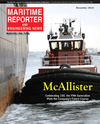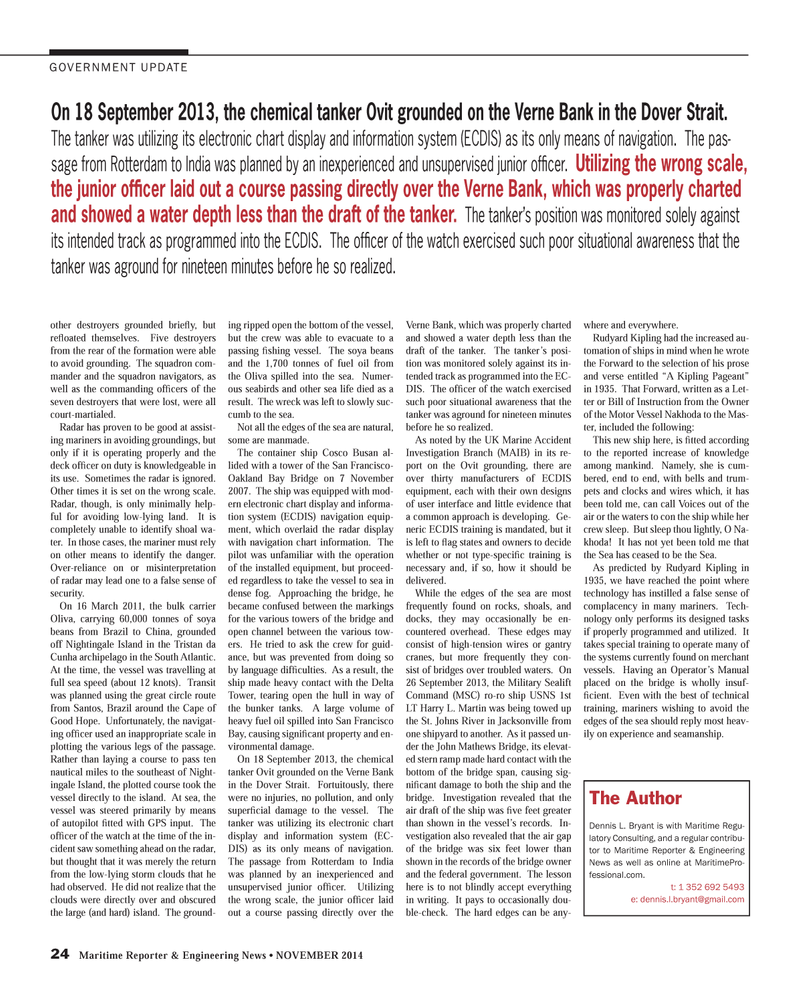
Page 24: of Maritime Reporter Magazine (November 2014)
Workboat Edition
Read this page in Pdf, Flash or Html5 edition of November 2014 Maritime Reporter Magazine
24 Maritime Reporter & Engineering News • NOVEMBER 2014
GOVERNMENT UPDATE other destroyers grounded brie? y, but re? oated themselves. Five destroyers from the rear of the formation were able to avoid grounding. The squadron com- mander and the squadron navigators, as well as the commanding of? cers of the seven destroyers that were lost, were all court-martialed.
Radar has proven to be good at assist- ing mariners in avoiding groundings, but only if it is operating properly and the deck of? cer on duty is knowledgeable in its use. Sometimes the radar is ignored.
Other times it is set on the wrong scale.
Radar, though, is only minimally help- ful for avoiding low-lying land. It is completely unable to identify shoal wa- ter. In those cases, the mariner must rely on other means to identify the danger.
Over-reliance on or misinterpretation of radar may lead one to a false sense of security.
On 16 March 2011, the bulk carrier
Oliva, carrying 60,000 tonnes of soya beans from Brazil to China, grounded off Nightingale Island in the Tristan da
Cunha archipelago in the South Atlantic.
At the time, the vessel was travelling at full sea speed (about 12 knots). Transit was planned using the great circle route from Santos, Brazil around the Cape of
Good Hope. Unfortunately, the navigat- ing of? cer used an inappropriate scale in plotting the various legs of the passage.
Rather than laying a course to pass ten nautical miles to the southeast of Night- ingale Island, the plotted course took the vessel directly to the island. At sea, the vessel was steered primarily by means of autopilot ? tted with GPS input. The of? cer of the watch at the time of the in- cident saw something ahead on the radar, but thought that it was merely the return from the low-lying storm clouds that he had observed. He did not realize that the clouds were directly over and obscured the large (and hard) island. The ground- ing ripped open the bottom of the vessel, but the crew was able to evacuate to a passing ? shing vessel. The soya beans and the 1,700 tonnes of fuel oil from the Oliva spilled into the sea. Numer- ous seabirds and other sea life died as a result. The wreck was left to slowly suc- cumb to the sea.
Not all the edges of the sea are natural, some are manmade.
The container ship Cosco Busan al- lided with a tower of the San Francisco-
Oakland Bay Bridge on 7 November 2007. The ship was equipped with mod- ern electronic chart display and informa- tion system (ECDIS) navigation equip- ment, which overlaid the radar display with navigation chart information. The pilot was unfamiliar with the operation of the installed equipment, but proceed- ed regardless to take the vessel to sea in dense fog. Approaching the bridge, he became confused between the markings for the various towers of the bridge and open channel between the various tow- ers. He tried to ask the crew for guid- ance, but was prevented from doing so by language dif? culties. As a result, the ship made heavy contact with the Delta
Tower, tearing open the hull in way of the bunker tanks. A large volume of heavy fuel oil spilled into San Francisco
Bay, causing signi? cant property and en- vironmental damage.
On 18 September 2013, the chemical tanker Ovit grounded on the Verne Bank in the Dover Strait. Fortuitously, there were no injuries, no pollution, and only super? cial damage to the vessel. The tanker was utilizing its electronic chart display and information system (EC-
DIS) as its only means of navigation.
The passage from Rotterdam to India was planned by an inexperienced and unsupervised junior of? cer. Utilizing the wrong scale, the junior of? cer laid out a course passing directly over the
Verne Bank, which was properly charted and showed a water depth less than the draft of the tanker. The tanker’s posi- tion was monitored solely against its in- tended track as programmed into the EC-
DIS. The of? cer of the watch exercised such poor situational awareness that the tanker was aground for nineteen minutes before he so realized.
As noted by the UK Marine Accident
Investigation Branch (MAIB) in its re- port on the Ovit grounding, there are over thirty manufacturers of ECDIS equipment, each with their own designs of user interface and little evidence that a common approach is developing. Ge- neric ECDIS training is mandated, but it is left to ? ag states and owners to decide whether or not type-speci? c training is necessary and, if so, how it should be delivered.
While the edges of the sea are most frequently found on rocks, shoals, and docks, they may occasionally be en- countered overhead. These edges may consist of high-tension wires or gantry cranes, but more frequently they con- sist of bridges over troubled waters. On 26 September 2013, the Military Sealift
Command (MSC) ro-ro ship USNS 1st
LT Harry L. Martin was being towed up the St. Johns River in Jacksonville from one shipyard to another. As it passed un- der the John Mathews Bridge, its elevat- ed stern ramp made hard contact with the bottom of the bridge span, causing sig- ni? cant damage to both the ship and the bridge. Investigation revealed that the air draft of the ship was ? ve feet greater than shown in the vessel’s records. In- vestigation also revealed that the air gap of the bridge was six feet lower than shown in the records of the bridge owner and the federal government. The lesson here is to not blindly accept everything in writing. It pays to occasionally dou- ble-check. The hard edges can be any- where and everywhere.
Rudyard Kipling had the increased au- tomation of ships in mind when he wrote the Forward to the selection of his prose and verse entitled “A Kipling Pageant” in 1935. That Forward, written as a Let- ter or Bill of Instruction from the Owner of the Motor Vessel Nakhoda to the Mas- ter, included the following:
This new ship here, is ? tted according to the reported increase of knowledge among mankind. Namely, she is cum- bered, end to end, with bells and trum- pets and clocks and wires which, it has been told me, can call Voices out of the air or the waters to con the ship while her crew sleep. But sleep thou lightly, O Na- khoda! It has not yet been told me that the Sea has ceased to be the Sea.
As predicted by Rudyard Kipling in 1935, we have reached the point where technology has instilled a false sense of complacency in many mariners. Tech- nology only performs its designed tasks if properly programmed and utilized. It takes special training to operate many of the systems currently found on merchant vessels. Having an Operator’s Manual placed on the bridge is wholly insuf- ? cient. Even with the best of technical training, mariners wishing to avoid the edges of the sea should reply most heav- ily on experience and seamanship.
The Author
Dennis L. Bryant is with Maritime Regu- latory Consulting, and a regular contribu- tor to Maritime Reporter & Engineering
News as well as online at MaritimePro- fessional.com. t: 1 352 692 5493 e: [email protected]
On 18 September 2013, the chemical tanker Ovit grounded on the Verne Bank in the Dover Strait.
The tanker was utilizing its electronic chart display and information system (ECDIS) as its only means of navigation. The pas- sage from Rotterdam to India was planned by an inexperienced and unsupervised junior offi cer. Utilizing the wrong scale, the junior offi cer laid out a course passing directly over the Verne Bank, which was properly charted and showed a water depth less than the draft of the tanker. The tanker’s position was monitored solely against its intended track as programmed into the ECDIS. The offi cer of the watch exercised such poor situational awareness that the tanker was aground for nineteen minutes before he so realized.
MR #11 (18-25).indd 24 10/23/2014 11:14:52 AM

 23
23

 25
25
